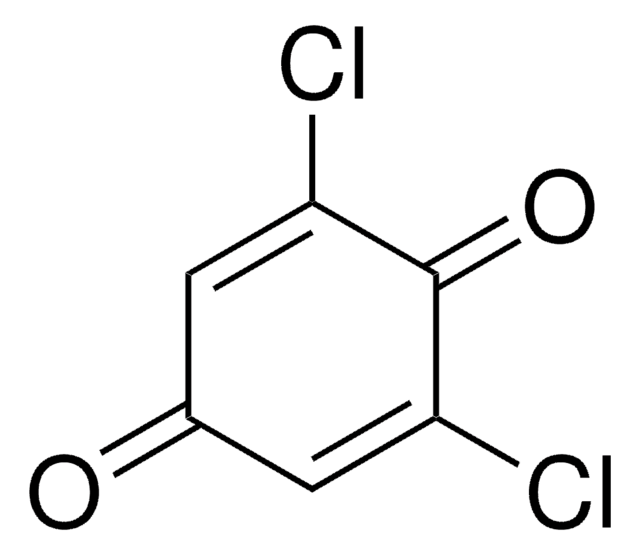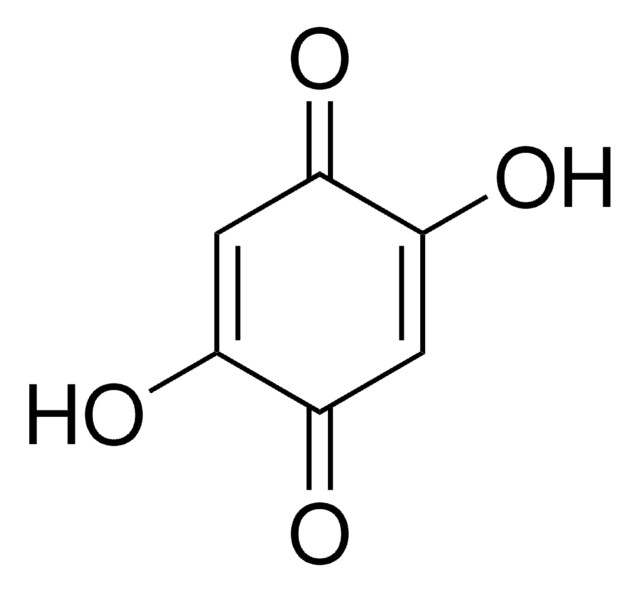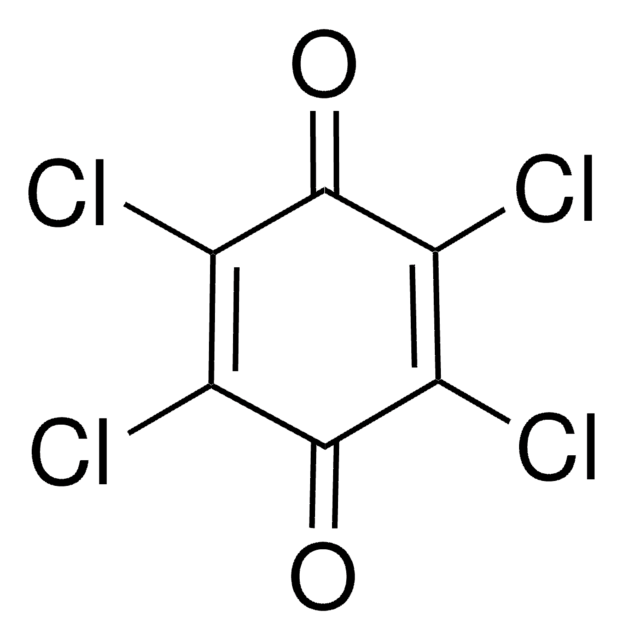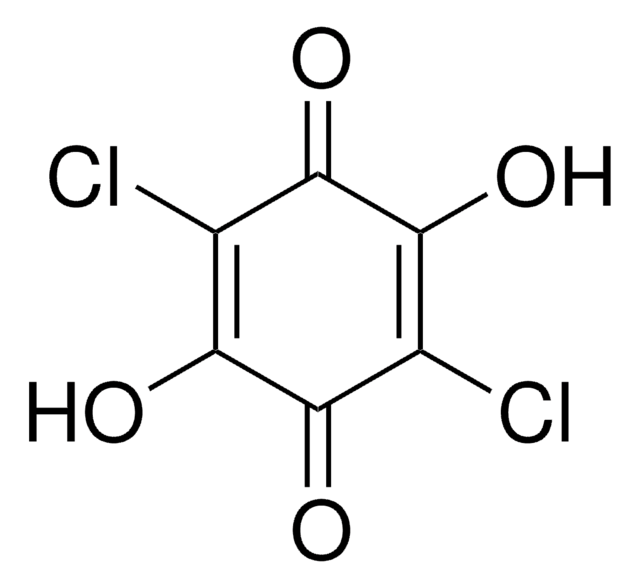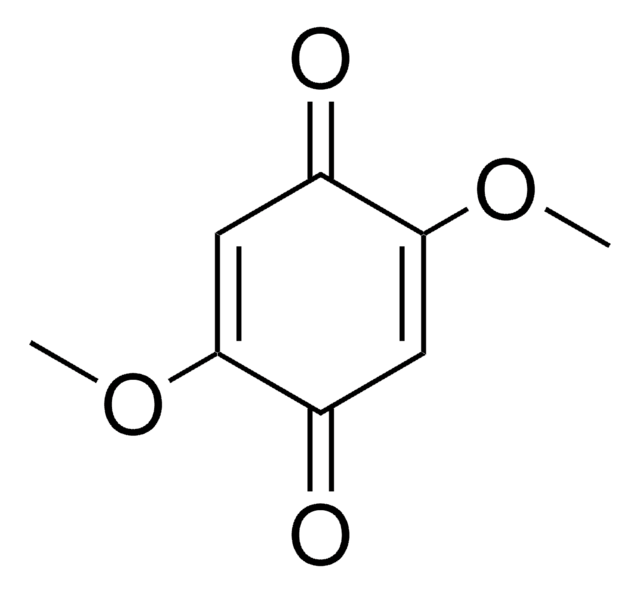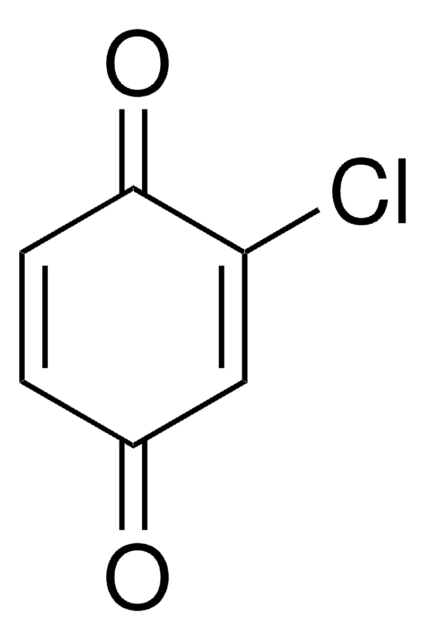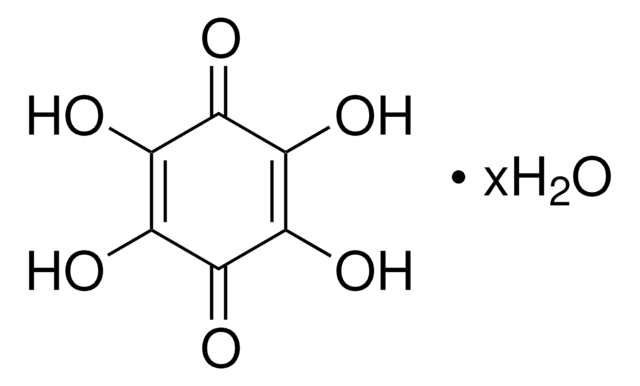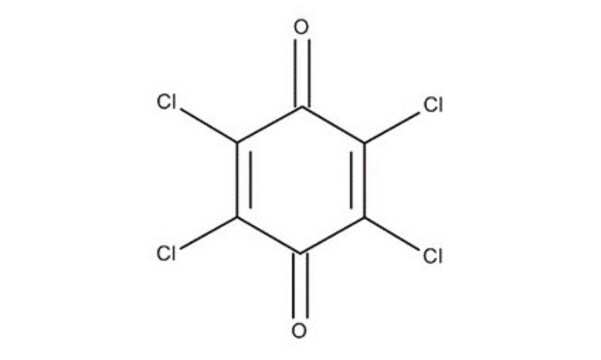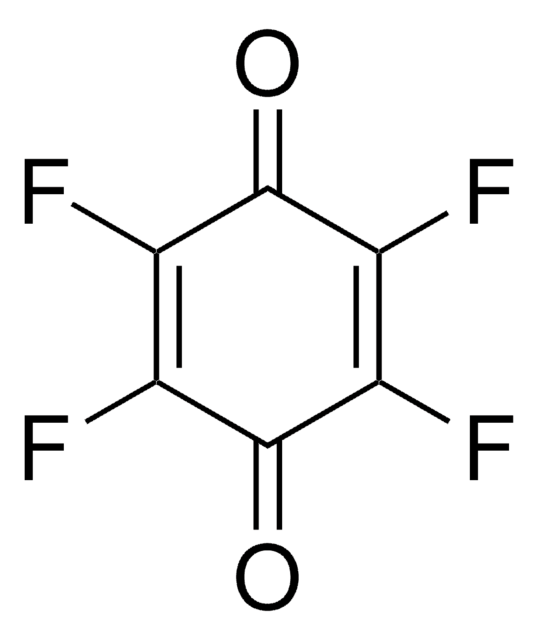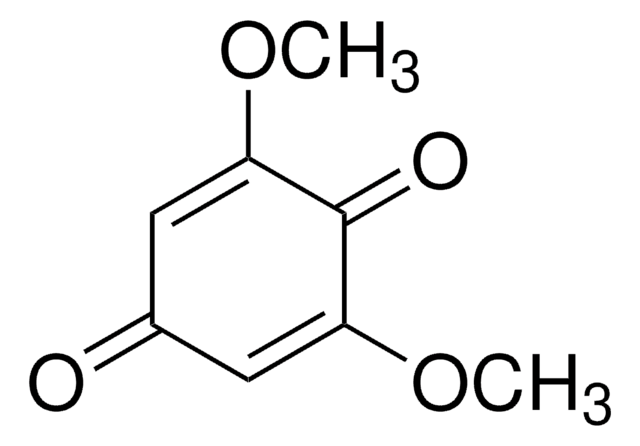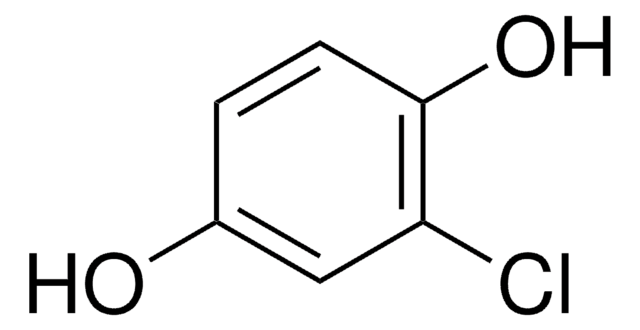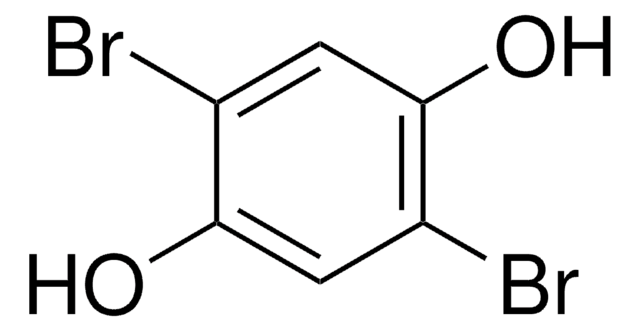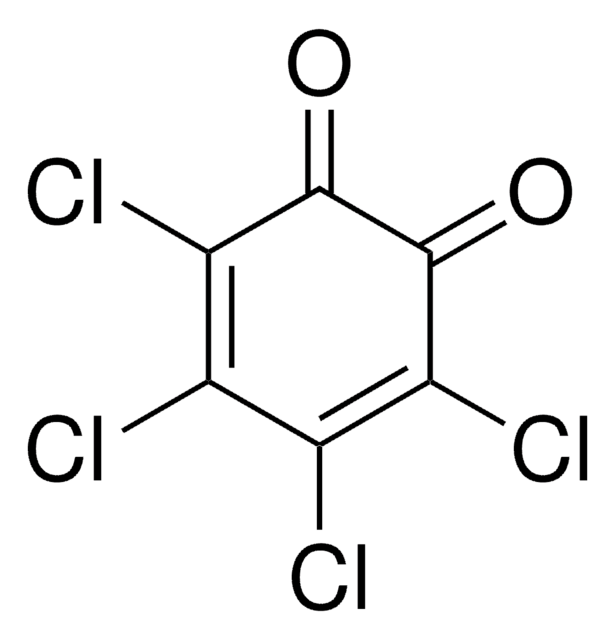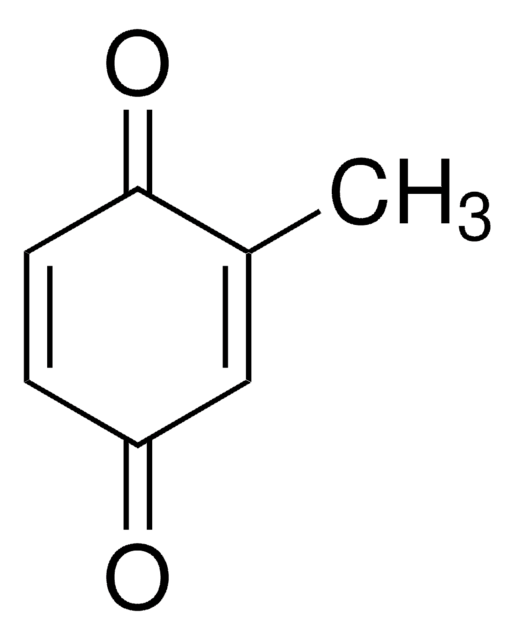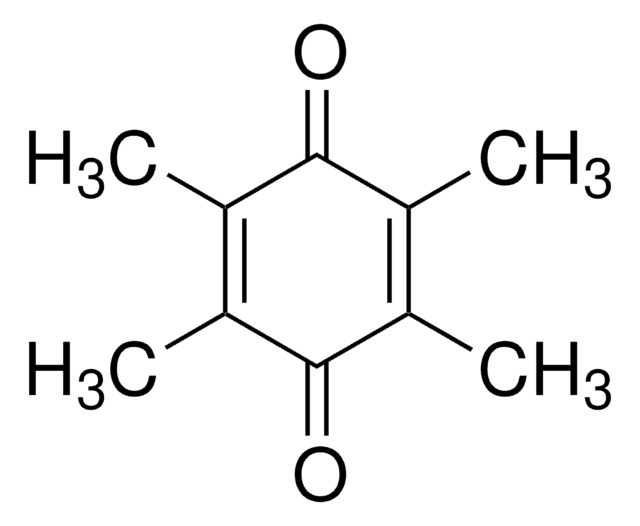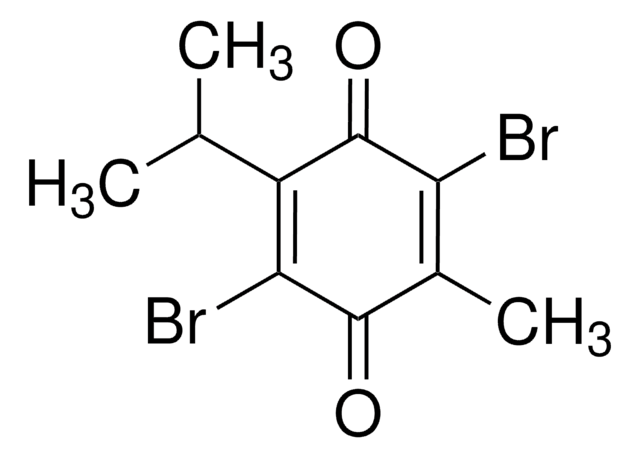Wszystkie zdjęcia(1)
Kluczowe dokumenty
431974
2,5-Dichloro-1,4-benzoquinone
98%
Synonim(y):
2,5-Dichloro-2,5-cyclohexadiene-1,4-dione, 2,5-Dichloro-p-benzoquinone
Zaloguj sięWyświetlanie cen organizacyjnych i kontraktowych
About This Item
Wzór empiryczny (zapis Hilla):
C6H2Cl2O2
Numer CAS:
Masa cząsteczkowa:
176.98
Numer WE:
Numer MDL:
Kod UNSPSC:
12352100
Identyfikator substancji w PubChem:
NACRES:
NA.22
Polecane produkty
Poziom jakości
Próba
98%
mp
160-163 °C (lit.)
grupa funkcyjna
chloro
ketone
ciąg SMILES
ClC1=CC(=O)C(Cl)=CC1=O
InChI
1S/C6H2Cl2O2/c7-3-1-5(9)4(8)2-6(3)10/h1-2H
Klucz InChI
LNXVNZRYYHFMEY-UHFFFAOYSA-N
Powiązane kategorie
Opis ogólny
2,5-Dichloro-1,4-benzoquinone (DCBQ) is a halogenated quinone. DCBQs are carcinogenic intermediates.They have benn identified as chlorination disinfection byproducts in drinking water. DCBQ has been reported to increse the decomposition of a model ROOH tert-butylhydroperoxide, via formation of t-butoxyl radicals. The isomers of the DCBQ dimer have been investigated for the non-covalent interactions (NCIs) by quantum chemical calculations. Halogen bond present in 2,5-dichloro-1,4-benzoquinone have been investigated by experimental as well as theoretical charge density analysis. Its reaction with pyrrolidine has been investigated.
Zastosowanie
2,5-Dichloro-1,4-benzoquinone may be used in the following processes:
- As a starting material in the synthesis of asterriquinone D.
- As a model to study the utility of a novel photoreactor with LED (light-emitting diode) light source and a fibre-optic CCD (charge-coupled device) spectrophotometer.
- 2,5-dichloro-3,6-bi(3-indolyl)-1,4-hydroquinone synthesis by palladium catalyzed reaction with indole.
Ta strona może zawierać tekst przetłumaczony maszynowo.
Hasło ostrzegawcze
Warning
Zwroty wskazujące rodzaj zagrożenia
Zwroty wskazujące środki ostrożności
Klasyfikacja zagrożeń
Eye Irrit. 2 - Skin Irrit. 2 - STOT SE 3
Organy docelowe
Respiratory system
Kod klasy składowania
11 - Combustible Solids
Klasa zagrożenia wodnego (WGK)
WGK 3
Temperatura zapłonu (°F)
Not applicable
Temperatura zapłonu (°C)
Not applicable
Środki ochrony indywidualnej
dust mask type N95 (US), Eyeshields, Gloves
Wybierz jedną z najnowszych wersji:
Masz już ten produkt?
Dokumenty związane z niedawno zakupionymi produktami zostały zamieszczone w Bibliotece dokumentów.
Klienci oglądali również te produkty
B Vijaya Pandiyan et al.
Physical chemistry chemical physics : PCCP, 16(37), 19928-19940 (2014-08-15)
The competition between non-covalent interactions (NCIs), such as C-H∙∙∙O, C-H∙∙∙Cl, C-Cl∙∙∙O, C-Cl∙∙∙Cl-C, C-O∙∙∙C, C-Cl∙∙∙C and C-O∙∙∙π, in the isomers of the 2,5-dichloro-1,4-benzoquinone (DCBQ) dimer were investigated by quantum chemical calculations to study the properties of the ground and excited states.
Halogen bonding in 2, 5-Dichloro-1, 4-benzoquinone: Insights from experimental and theoretical charge density analysis.
Hathwar VR, et al.
Crystal Growth & Design, 11(5), 1855-1862 (2011)
Chun-Hua Huang et al.
Chemical research in toxicology, 28(5), 831-837 (2015-03-20)
Halogenated quinones (XQ) are a class of carcinogenic intermediates and newly identified chlorination disinfection byproducts in drinking water. Organic hydroperoxides (ROOH) can be produced both by free radical reactions and enzymatic oxidation of polyunsaturated fatty acids. ROOH have been shown
Virág Kiss et al.
Photochemical & photobiological sciences : Official journal of the European Photochemistry Association and the European Society for Photobiology, 16(4), 519-526 (2016-12-13)
Substituted 1,4-benzoquinone (QR) derivatives are photosensitive in aqueous solution and form hydroquinones (QR-H
Construction of a photochemical reactor combining a CCD spectrophotometer and a LED radiation source.
Gombar M, et al.
Photochemical & Photobiological Sciences : Official Journal of the European Photochemistry Association and the European Society for Photobiology, 11(10), 1592-1595 (2012)
Nasz zespół naukowców ma doświadczenie we wszystkich obszarach badań, w tym w naukach przyrodniczych, materiałoznawstwie, syntezie chemicznej, chromatografii, analityce i wielu innych dziedzinach.
Skontaktuj się z zespołem ds. pomocy technicznej